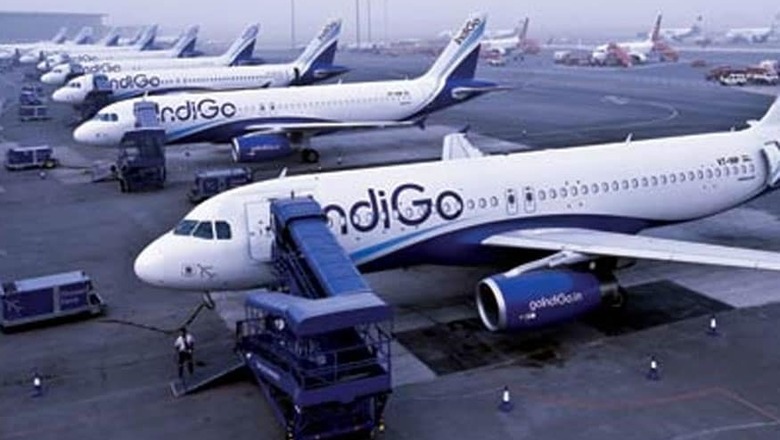
views
India’s aviation industry has been hit the hardest by the Covid-19 pandemic and its fallout. Flights were grounded for the better part of the June quarter and even now only one in two are allowed to ply on domestic routes. This has meant deep losses for all airlines as fixed costs remained but revenues dried up for an entire quarter. Even the current quarter (July-September) is expected to bring in scant revenues for airlines due to continued uncertainties on travel and the whole of 2020-21 could well be a washout year.
Saddled with fixed costs and only meager earnings, airlines have been forced to defer delivery of new aircraft as even after flight resumption, load factors (number of occupied seats per aircraft) remain abysmally low. Not just deferring aircraft deliveries, airlines have also had to slash employee salaries, cut jobs and defer payments to vendors, oil companies and other creditors. Sources have indicated that Air India alone could be sitting on vendor dues of “tens of thousands” of crores and that most airlines with weak financials are deferring payments to remain viable. Industry estimates suggest every third job could be cut and the industry wide loss could hit a record for the year.
In this scenario, it was inevitable that the industry would witness some consolidation even as it scouts for funds to urgently capitalise airlines.
So the reports of AirAsia BhD being in talks with Tata Sons for exiting the Indian arm come as no surprise. AirAsia India is a two-way joint venture with Tata Sons, with the Malaysian partner holding 49 per cent equity and reports have suggested that the Indian partner may buy out AirAsia BhD at a discount. Tata Sons declined to offer any comment on the matter. But any selloff by AirAsia BhD will mean the Tatas get to own and operate two majority owned airlines in India (since the group already has majority 51 per cent stake in Vistara). Will they want to continue with both?
Anyway, an indication of the Malaysian company’s possible exit from India had come last month itself, when CEO Tony Fernandes had said in a conference call with Credit Suisse analysts that India and Japan were only “peripheral” markets for the airline. “While currently growing and committed, we would never say that we would never exit India,” Fernandes had been quoted saying by CS.
It would be fair to say that AirAsia’s journey in India, since inception seven years ago, has been dotted with troubles. And the current situation, brought about by the pandemic and consequent assault on airline industry’s fortunes, may only exacerbate the pain. A source had said earlier that a significant fleet expansion done by AA India last year could turn into the airline’s biggest headache in these times. As per government restrictions, only a part of the capacity can be deployed and that too only on domestic routes in India, rendering the remaining aircraft idle and adding significantly to the airline’s costs.
“When fleet expands, more money is needed to maintain the aircraft, use them. Also, more money is needed to subsidize the losses,” this source had pointed out. AirAsia India has never reported a profit though it had narrowed losses year-on-year last fiscal. “AirAsia had narrowed losses quite significantly last fiscal but the situation brought on by Covid19 means India and Japan operations are struggling. Unlike other markets, India needs lots of funds. The airline now has a fleet of 30 aircraft – it added nearly a dozen aircraft in a short period of time before Covid19 and thus needs to pump in more money to fund the increased losses as capacity sits idle,” the source had added.
The tough decisions that await the promoters of AirAsia India are similar to what better funded and larger airlines are also struggling with currently. An analysis by global aviation consultancy CAPA has highlighted the massive funds needed by the industry to get through these trying times. Excluding market leader IndiGo, Indian airlines will need up to $3-3.5 billion of recapitalization or anywhere between Rs 22,000 crore to Rs 26, 000 crore and any delay in such a massive funds infusion “may inflict further damage (including in the case of Air India) and could serve as a catalyst for consolidation.”
As of now, India has five scheduled airlines – Air India, Vistara, Spicejet, Go Air and AirAsia India. Consolidation could result in a significant change in the structure of the industry, CAPA said, adding we may be left with just 2 to 3 airlines if timely recapitalisation did not happen. A large airline, Jet Airways, was grounded in April last year for want of massive funds; Air India has been up for sale through a government mandated disinvestment process and in any case, the airline industry is expected to post a record combined loss for the June quarter. CAPA has, in fact, said that market leader IndiGo could account for as high as 70 per cent of the market, even if it does not expand operations, purely due to widespread consolidation in the market.
Amid all this industry chaos, not only has the government offered no specific package to help the airline industry out of the morass, it has capped domestic fares thus further hurting airline balance sheets. An industry veteran had said earlier that earlier airlines were offering tickets at prices well below the floor currently set by the government but these prices were for limited seats and the policy of dynamic fares allowed them to make up the difference by offering higher fares closer to the date of travel. Now that fare bands have been prescribed, pricing flexibility has been denied to the carriers.
Airlines are doing their bit to remain solvent. IndiGo, for example, has taken cost reduction initiatives such as pay cuts of up to 25 per cent, cut capex and renegotiated terms with vendors, suppliers and lessors. But to be able to survive the aftermath of Covid19, India’s airlines not only need a massive doze of funds, they also require the confidence of the travelling public. Both these factors seem to be in short supply at the moment.

















Comments
0 comment